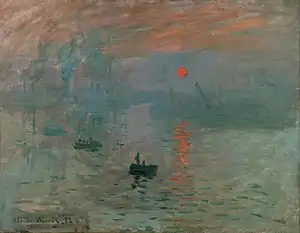Edward Francis Rook
Edward Francis Rook (September 21, 1870 New York City – October 25, 1960 Old Lyme, Connecticut) was an American Impressionist landscape and marine painter, and a member of the art colony at Old Lyme, Connecticut.
Edward Francis Rook | |
|---|---|
| Born | September 21, 1870 |
| Died | October 25, 1960 Old Lyme, Connecticut |
| Occupation(s) | American Impressionist landscape and marine painter |
| Spouse | Edith Stone |

Biography
Rook studied at the Art Students League of New York, 1889–91, under John Twachtman.[1] He studied further in Paris at the Académie Julian under Jean-Joseph Benjamin-Constant and Jean-Paul Laurens, then at the École des Beaux-Arts under Jean-Léon Gérôme.[1]
Rook returned to the United States in 1900, and married a childhood friend, Edith Stone, in 1901.[2] They travelled to Canada and California, and spent close to a year in Mexico.[2] Rook had known Childe Hassam in France, and painted with him at Old Lyme during the summer of 1903.[2] After living in New York City, the Rooks settled in Old Lyme in April 1905.[2]
Rook was a recluse and a bit of an eccentric. In Henry Rankin Poore's mural The Fox Chase (1905), at the Florence Griswold Museum, he is depicted in the background, carrying two large canvases and ignoring the tomfoolery of the other artists.[3] Rook collected cars and built a house around his garage, although he never learned to drive.[2]
Exhibitions, awards and honors
Rook exhibited one work, Moonrise, Normandy, at the 1893 World's Columbian Exposition in Chicago, Illinois.[4] He exhibited regularly at the Pennsylvania Academy of the Fine Arts from 1897 to 1913 and 1917 to 1919,[5] which awarded him its 1898 Temple Gold Medal (for Pearl Clouds—Moonlight).[6] He was awarded a bronze medal at the 1901 Pan-American Exposition in Buffalo, New York (for Pearl Clouds—Moonlight, The Mountain Brook, and The Inn—Moonlight); two silver medals at the 1904 World's Fair in St. Louis, Missouri (for his oil-on-canvas landscapes of Mexico, and for a pastel: Horse Market);[7] a silver medal at the 1910 Exposición Internacional del Centenario in Buenos Aires, Argentina (for Canada in Snow);[8] and a gold medal at the 1915 Panama-Pacific International Exhibition in San Francisco (for Snow, Ice and Foam).[9] The Corcoran Gallery of Art awarded him its 1919 bronze medal (for Peonies).[10] He exhibited at the Lyme Art Association from 1904 to 1943, which awarded him its 1929 first prize (for Reflections in a Samovar).[11]
He was elected an Associate of the National Academy of Design in 1908, and an Academician in 1924.[1]
A retrospective exhibition of Rook's work was held at the Florence Griswold Museum in 1987, which holds a number of his works.[2] His works are also in the collections of the Pennsylvania Academy of the Fine Arts,[12] the National Academy Museum, the Cincinnati Art Museum, the New Britain Museum of American Art and other museums, along with various Connecticut institutions.
References
- David B. Dearinger, "Edward Francis Rook, Jr." Paintings and Sculpture at the National Academy of Design, Volume 1: 1826-1925 (National Academy, Hudson Hill Publishers, 2004), pp. 479-80.
- Diane Pietrucha Fischer, Edward F. Rook, 1870–1960, American Impressionist, exhibition catalogue, (Florence Griswold Museum, 1987).
- Fox Chase - Edward Rook, from Florence Griswold Museum.
- Caroline Kinder Carr, et al., Revisiting the White City: American Art at the 1893 World's Fair (Smithsonian Institution, University Press of New England, 1993), p. 310.
- Peter Hastings Falk, ed., The Annual Exhibition Record of the Pennsylvania Academy of the Fine Arts, Volume 3, 1914-1968 (Madison, CT: Sound View Press, 1989), p. 396.
- Peter Hastings Falk, ed., The Annual Exhibition Record of the Pennsylvania Academy of the Fine Arts, Volume 2, 1876-1913 (Madison, CT: Sound View Press, 1989), p. 413.
- Official Catalogue of Exhibitors, Universal Exposition, St. Louis, U.S.A. 1904 (St. Louis: The Official Catalogue Company, 1904), pp. 160, 172.
- Exposición Internacional de Bellas Artes: Catálogo Oficial Ilustrado (Moneda esquina San Antonio, 1910), p. 62.
- Illustrated Catalogue of the Panama–Pacific International Exposition, Department of Fine Arts (San Francisco Art Association, 1916), p. 16.
- The American Art Annual, Volume 17 (MacMillan Company, American Federation of Arts, 1920), p. 58.
- "Reflections in a Samovar" by Edward F. Rook, from Internet Archive.
- "Deserted Street, Moonlight," from PAFA.
External links
- Edward Francis Rook, at Smithsonian Institution Research Information System
- Obituary: "Edward F. Rook, 90, Connecticut Artist," The New York Times, October 27, 1960
